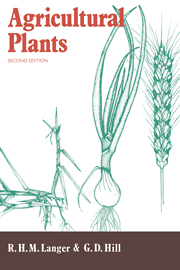Book contents
- Frontmatter
- Contents
- Preface to the first edition
- Preface to the second edition
- 1 World population and crop production
- 2 Plant structure
- 3 Liliaceae
- 4 Poaceae
- 5 Apiaceae
- 6 Asteraceae
- 7 Brassicaceae
- 8 Cannabinaceae
- 9 Chenopodiaceae
- 10 Cucurbitaceae
- 11 Fabaceae
- 12 Lamiaceae
- 13 Linaceae
- 14 Malvaceae
- 15 Papaveraceae
- 16 Solanaceae
- 17 Physiological basis of yield
- Index of specific names
- Subject index
6 - Asteraceae
Published online by Cambridge University Press: 05 June 2012
- Frontmatter
- Contents
- Preface to the first edition
- Preface to the second edition
- 1 World population and crop production
- 2 Plant structure
- 3 Liliaceae
- 4 Poaceae
- 5 Apiaceae
- 6 Asteraceae
- 7 Brassicaceae
- 8 Cannabinaceae
- 9 Chenopodiaceae
- 10 Cucurbitaceae
- 11 Fabaceae
- 12 Lamiaceae
- 13 Linaceae
- 14 Malvaceae
- 15 Papaveraceae
- 16 Solanaceae
- 17 Physiological basis of yield
- Index of specific names
- Subject index
Summary
The Asteraceae (Compositae) are one of the oldest groups of higher plants. They are also the largest family and include about one tenth of all species, over 20 000, which are distributed widely throughout the world. It is therefore somewhat surprising that the family should be best known for the weeds and wild plants it contains. Only a few genera have provided plants of economic value. The sunflower and safflower have been developed as oil seed crops, lettuce and endive as salad vegetables, pyrethrum as a source of insecticide, and a few other species because of their mineral or aromatic content. The family used to derive its name from the fact that the flowers do not occur singly but in composite inflorescences which take the form of a flower head or capitulum. Each capitulum consists of a receptacle surrounded by one or more whorls of bracts, jointly referred to as the involucre. Inserted on the receptacle are small flowers or florets, tightly packed together varying from a few to several hundreds according to the species. Each individual flower has an inferior ovary containing a single ovule. The single, usually forked style is surrounded by a tube formed by five stamens with their anthers joined. There are five petals which are united to form a corolla tube, but the sepals are either absent or represented by a ring of fine hairs, called the pappus, which play a part in seed dispersal.
- Type
- Chapter
- Information
- Agricultural Plants , pp. 154 - 167Publisher: Cambridge University PressPrint publication year: 1991



